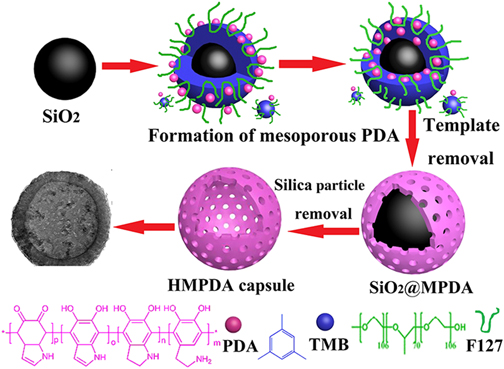Crossref Citations
This article has been cited by the following publications. This list is generated based on data provided by
Crossref.
Mavridi-Printezi, Alexandra
Guernelli, Moreno
Menichetti, Arianna
and
Montalti, Marco
2020.
Bio-Applications of Multifunctional Melanin Nanoparticles: From Nanomedicine to Nanocosmetics.
Nanomaterials,
Vol. 10,
Issue. 11,
p.
2276.
Cuzzubbo, Stefania
and
Carpentier, Antoine F.
2021.
Applications of Melanin and Melanin-Like Nanoparticles in Cancer Therapy: A Review of Recent Advances.
Cancers,
Vol. 13,
Issue. 6,
p.
1463.
Lin, Lanlan
Li, Haiyang
Chen, Zekun
Wen, Xinyu
Yan, Rui
Liu, Lei
and
Tao, Caihong
2022.
Construction of MPDA@IR780 nano drug carriers and photothermal therapy of tumor cells.
Journal of Drug Delivery Science and Technology,
Vol. 76,
Issue. ,
p.
103819.
Lin, Lanlan
Li, Haiyang
Su, Sisi
Wen, Xinyu
Yan, Rui
and
Tao, Caihong
2022.
Study on the structure and properties of Fe3O4@HMPDA@HA magnetic hollow mesoporous submicron drug-carrying system.
Microporous and Mesoporous Materials,
Vol. 330,
Issue. ,
p.
111582.
Tao, Caihong
Lin, Lanlan
Li, Haiyang
Chen, Zekun
Wen, Xinyu
Yan, Rui
and
Liu, Lei
2022.
Construction of Mpda@Ir780 Nano Drug Carriers and Photothermal Therapy of Tumor Cells.
SSRN Electronic Journal ,
Heidari, Samira
Akhlaghi, Mehdi
Sadeghi, Mahdi
Kheirabadi, Amin Mokhtari
Beiki, Davood
Ardekani, Alireza Emami
Rouhollah, Amir
Saeidzadeh, Parya
and
Soleyman, Rouhollah
2022.
Development of 64Cu-DOX/DOX-loaded chitosan-BSA multilayered hollow microcapsules for selective lung drug delivery.
Journal of Drug Delivery Science and Technology,
Vol. 73,
Issue. ,
p.
103477.
Busa, Prabhakar
Koutavarapu, Ravindranadh
and
Kuthati, Yaswanth
2022.
Polydopamine-Coated Copper-Substituted Mesoporous Silica Nanoparticles for Dual Cancer Therapy.
Coatings,
Vol. 12,
Issue. 1,
p.
60.
Han, Zehua
Gao, Minjie
Wang, Zhihua
Peng, Lichao
Zhao, Yanbao
and
Sun, Lei
2022.
pH/NIR-responsive nanocarriers based on mesoporous polydopamine encapsulated gold nanorods for drug delivery and thermo-chemotherapy.
Journal of Drug Delivery Science and Technology,
Vol. 75,
Issue. ,
p.
103610.
Yi, Mingyuan
Xiong, Siwen
Zhang, Yuxuan
Wan, Lihong
Chen, Fanfan
Gong, He
Yan, Sitong
Fang, Lin
and
Wang, Zhifen
2023.
Antioxidating and reinforcing effect of polydopamine functionalized silica on natural rubber latex films.
Journal of Applied Polymer Science,
Vol. 140,
Issue. 12,
Özcan, Sinem
Süngü Akdoğan, Çağıl Zeynep
Polat, Mustafa
Kip, Çiğdem
and
Tuncel, Ali
2023.
A new multimodal magnetic nanozyme and a reusable peroxymonosulfate oxidation catalyst: Manganese oxide coated-monodisperse-porous and magnetic core-shell microspheres.
Chemosphere,
Vol. 341,
Issue. ,
p.
140034.
Ain, Noor Ul
Khan, Bibimaryam
Zhu, Kehan
Ji, Wen
Tian, He
Yu, Xiaoxiao
Yi, Lin
Li, Duxin
and
Zhang, Zhenqing
2024.
Fabrication of mesoporous silica nanoparticles for releasable delivery of licorice polysaccharide at the acne site in topical application.
Carbohydrate Polymers,
Vol. 339,
Issue. ,
p.
122250.
Zhang, Tingyu
Yu, Yaru
Han, Shuiquan
Cong, Hailin
Kang, Chuankui
Shen, Youqing
and
Yu, Bing
2024.
Preparation and application of UPLC silica microsphere stationary phase:A review.
Advances in Colloid and Interface Science,
Vol. 323,
Issue. ,
p.
103070.
Yin, Qingyue
Xu, Liang
Chen, Zekun
Cui, Yidan
Zhao, Wenjing
Geng, Fukang
and
Tao, Caihong
2024.
Study on the application of hollow mesoporous polydopamine as a nanoparticle drug carrier in tumor combination therapy.
New Journal of Chemistry,
Vol. 48,
Issue. 40,
p.
17525.
Chen, Zekun
Yin, Qingyue
Xu, Liang
Guo, Wenwen
and
Tao, Caihong
2024.
Preparation and Photothermal Antimicrobial Performance of Triple Linkage Hydrogels.
Coatings,
Vol. 14,
Issue. 3,
p.
363.



